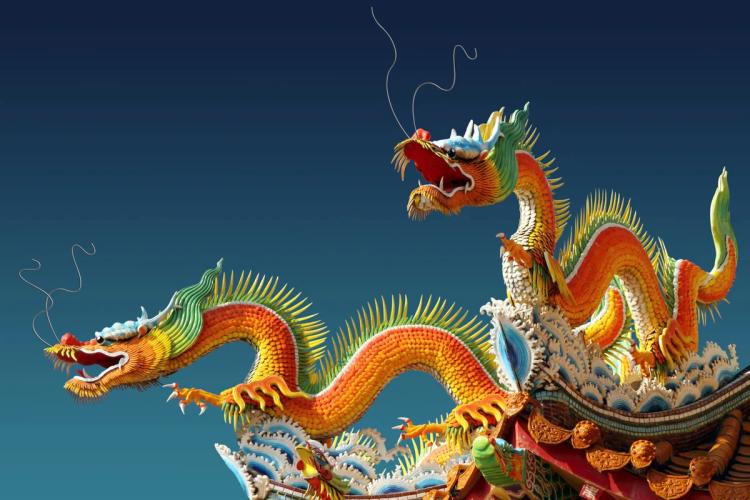Lunar New Year begins auspicious, perhaps fertile, Year of the Dragon
CU Boulder Asian languages faculty Yingjie Li and Yu Zhang reflect on what some consider the luckiest year in the Chinese zodiac
An interesting thing happened in 2012: China’s steadily declining national birth rate experienced something of a boom. While 2011 saw a birth rate of 13 per 1,000 people, the following year that number jumped to 15—and dropped back down to 13 in 2013.
While it may be impossible to pinpoint a single reason for the surge, a lot of people have a pretty good idea: dragons.
That year, 2012, was a Year of the Dragon on the Chinese zodiac. As the only mythical creature among 11 other real animals, dragons occupy a place of particular esteem not only in the zodiac, but in Chinese culture and imagination. For some, dragon years are so auspicious that they time their family planning accordingly.

Yingjie Li (left) is a CU Boulder teaching associate professor of Chinese and Yu Zhang (right) is a teaching assistant professor of Chinese.
When Lunar New Year begins Saturday, initiating a new Year of the Dragon, some experts anticipate—or even hope for—another dragon-year rise in Chinese birth rates, however slight.
“Dragon years are definitely considered some of the most auspicious,” explains Yu Zhang, a teaching assistant professor of Chinese in the University of Colorado Boulder Department of Asian Languages and Civilizations. “Maybe among younger generations, the (Chinese) zodiac isn’t as important as it used to be, but I would say there’s still a preference for dragon years.”
In fact, research published in 2020 suggests that beliefs about dragon-year children being destined for greatness and good fortune can become self-fulfilling prophecies. The researchers found “that parents of Dragon children have higher expectations for their children in comparison to other parents, and that they invest more heavily in their children in terms of time and money.”
Descendants of the dragon
Though historians and archaeologists have long debated when the dragon first gained prominence in Chinese culture, a tomb discovered in 1987 in China’s Henan Province revealed a 2-meter dragon statue dated to Neolithic times between 5,000 and 7,000 years ago.
Some archaeologists theorize that dragons came to prominence as Chinese agriculture developed. Dragons symbolized thunder as a harbinger of rain.
“Many people consider that phenomena like rain or thunder are related to the dragon, and in the past China was a farming country,” says Yingjie Li, a CU Boulder teaching associate professor of Chinese and Chinese language coordinator.
“Rainfall is very important for farming, for the harvest, so people formed the impression that the dragon is related to our life; the dragon somehow is related to whether we can earn a good living this year or not.”
Some fables hold that Huangdi, the famed Yellow Emperor who is mythologized as ancestor to all Han people, was taken into the afterlife by a dragon when he died in the second millennium BCE. And when Liu Bang became first emperor of the Han Dynasty around 200 BCE, stories were told that his mother had consorted with a dragon.
As the dragon became the symbol of emperors, it became the symbol of empire. It also evolved as a creature unlike dragons in Western myth and folklore.

Lunar New Year begins Saturday and welcomes a Year of the Dragon, considered one of the most auspicious years in the Chinese zodiac.
“The Chinese dragon is very different from the Western dragon,” Li says. “The Western dragon can be an evil image or a scary image; it lives in caves and comes from below. The Chinese dragon comes from the sky, and it’s considered very lucky and very auspicious. It’s a powerful symbol and some Chinese people even say that they are descendants of the dragon.”
In fact, she added, when she was growing up a popular song, especially for her parents’ generation, was called “Descendants of the Dragon (Long De Chuan Ren),” which was rerecorded in 2000 by pop artist Leehom Wang.
While China, like many countries and cultures, is seeing a decline in the importance of longstanding customs and traditions among younger generations, “during Lunar New Year certain traditions become very important,” Zhang says. “I would say younger generations have a lot less connection to the lunar calendar than older ones, but during Spring Festival we’re doing things like paper cutting and writing traditional characters—these are small things that I used to do in school, traditional customs.
“For my family, no one’s very good at calligraphy, but we will definitely buy well-written characters meaning happiness, we’ll buy well-written couplets, and hang them by the door on New Year’s Eve day. We’ll hang the red lanterns in the evening during Spring Festival, and these are very old customs.”
Did you enjoy this article? Subscribe to our newsletter. Passionate about Asian languages and civilizations? Show your support.

